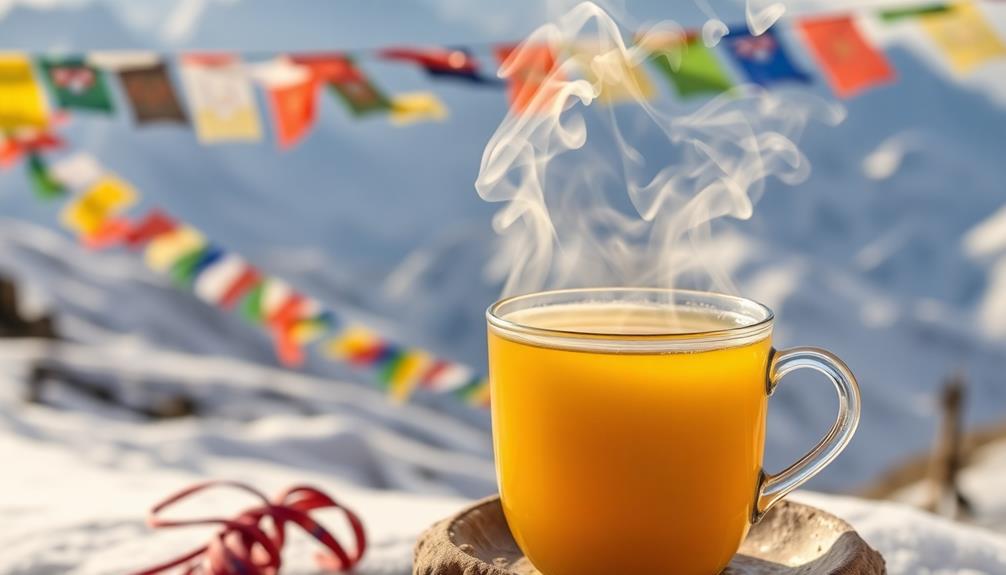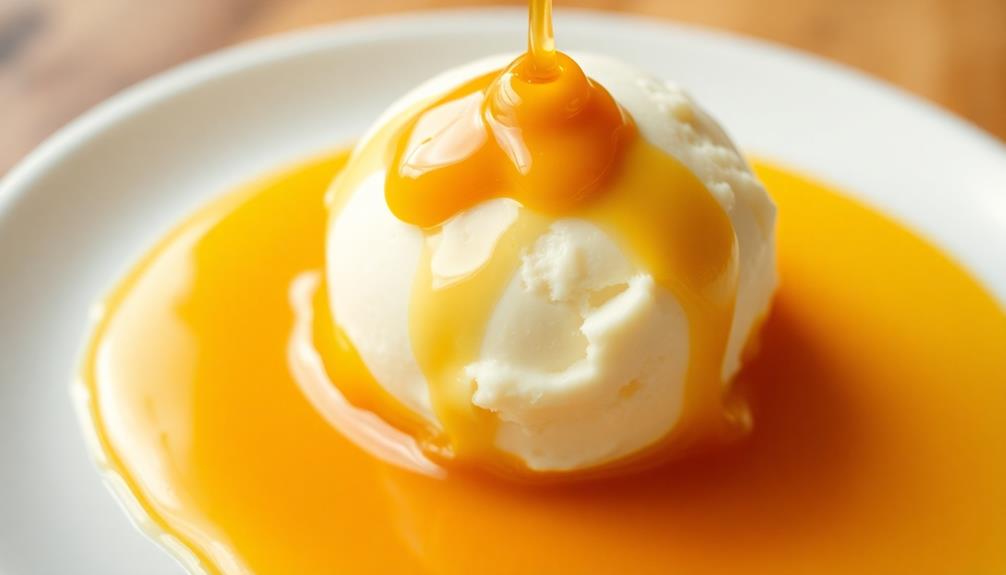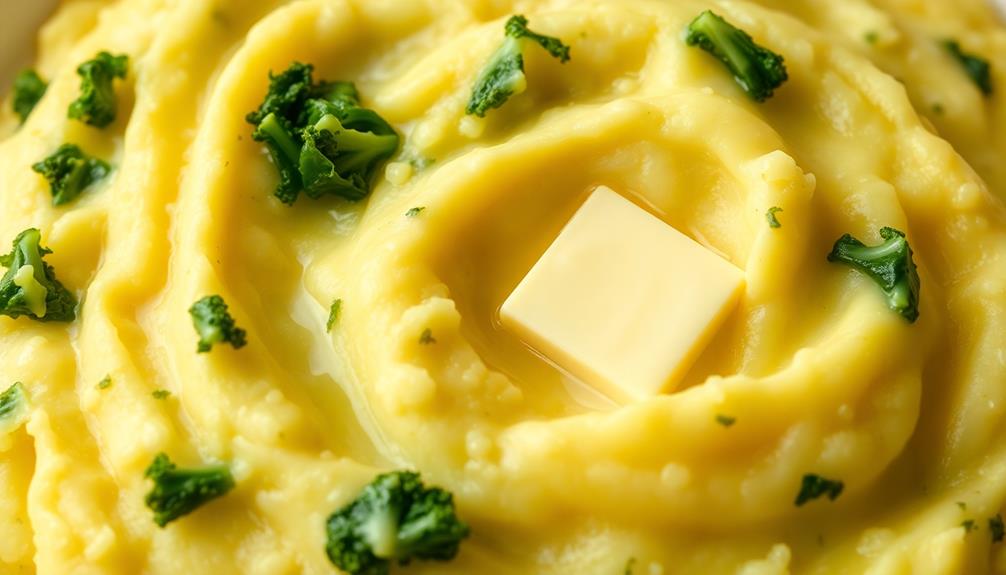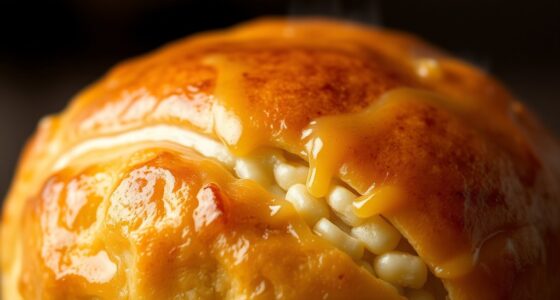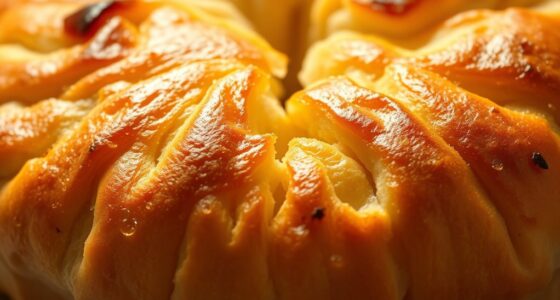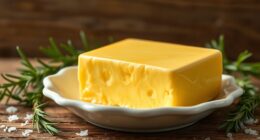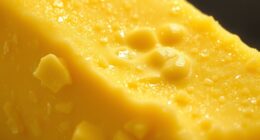Tibetan butter tea, a timeless beverage rooted in the resilient culture of the Tibetan people, is a unique and savory delight that'll warm you up in the harsh Himalayan climate. Tracing back to the 7th century, this traditional drink, known as 'po cha', has been a staple for nourishment and comfort among nomads and monks. Crafted with high-quality black tea, yak butter, salt, and water, the distinctive flavor profile warms the soul while offering nutritional benefits. More than just a tea, it's a cherished ritual that connects individuals to Tibetan heritage and identity. Intrigued to learn the fascinating history and time-honored preparation?
Key Takeaways
- Tibetan butter tea, known as 'po cha', is a centuries-old cultural staple that reflects the resilience and resourcefulness of the Tibetan people.
- Crafted with high-quality black tea leaves, yak butter, salt, and water, the unique flavor profile warms the soul and offers nutritional benefits.
- Preparation involves a rhythmic ritual of churning and blending the ingredients, serving as a calming communal experience in Tibetan culture.
- The tea provides warmth and energy in the harsh Himalayan climate, with the salt content aiding in hydration at high altitudes.
- Drinking Tibetan butter tea is more than just a beverage – it is an immersive cultural experience that celebrates the heritage and identity of the Tibetan people.
History
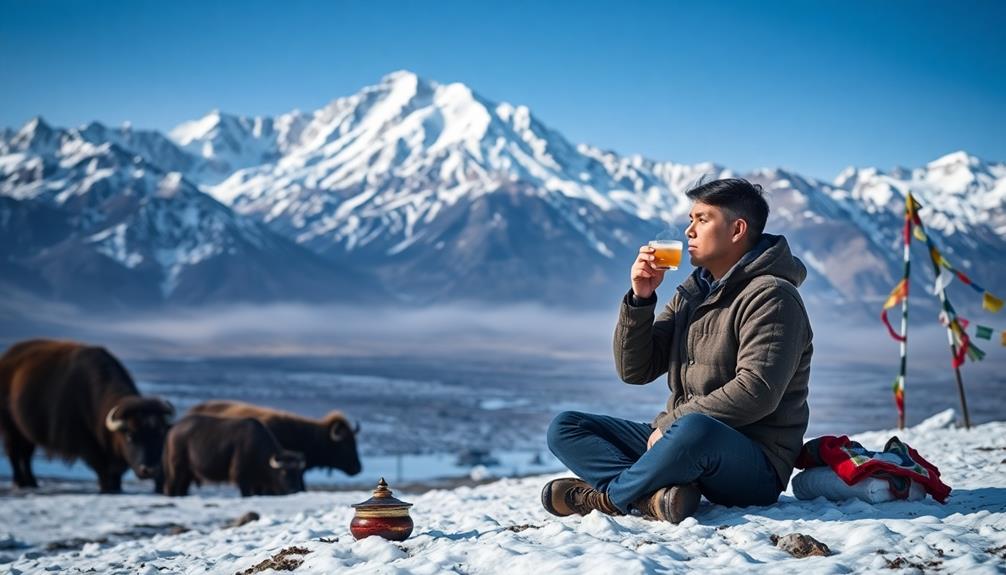
The origins of Tibetan butter tea, also known as 'po cha', can be traced back to the 7th century. This savory beverage has been a staple in Tibetan culture for centuries, providing essential nourishment and warmth in the high-altitude, frigid climate of the Himalayan region.
Traditionally prepared by combining black tea, yak butter, and sometimes salt, this unique concoction was initially consumed by Tibetan nomads and monks to combat the harsh, bitter cold. Over time, the recipe evolved, incorporating regional variations and personal preferences.
Today, butter tea remains a beloved part of Tibetan daily life, served as a welcoming gesture, a comforting ritual, and a source of sustenance. Its rich, creamy texture and robust flavor have captivated the hearts and palates of both Tibetans and curious adventurers from around the world, ensuring the enduring legacy of this iconic Himalayan beverage.
Recipe
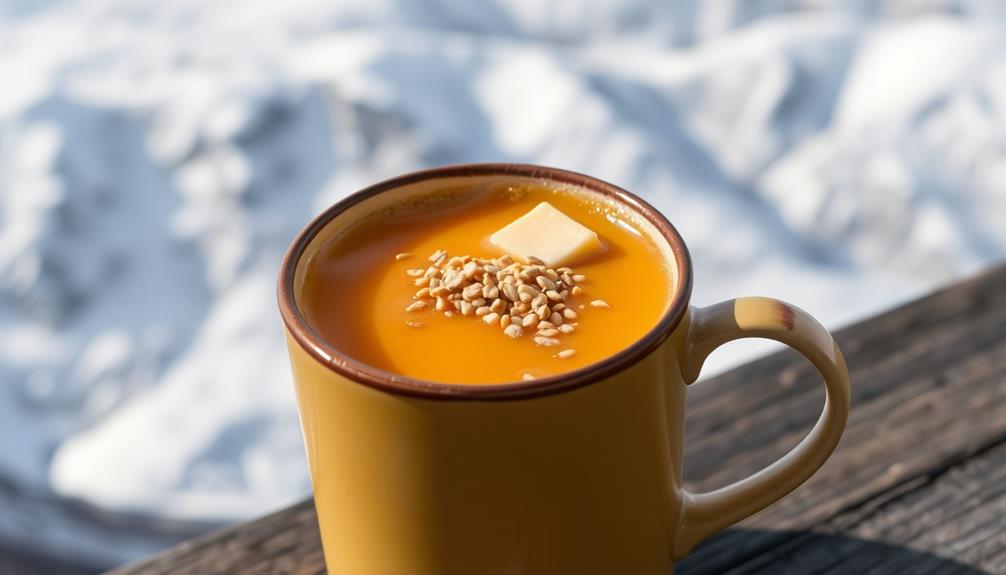
Tibetan butter tea, known as "po cha" in the Tibetan language, is a unique and traditional beverage that has been enjoyed for centuries in the Himalayan region. This rich and creamy tea is more than just a drink; it's a cultural tradition that reflects the resilience and resourcefulness of the Tibetan people.
The key to a perfect cup of Tibetan butter tea lies in the high-quality ingredients and the meticulous preparation process. The tea leaves, sourced from the high-altitude tea gardens of the Tibetan Plateau, are carefully selected and expertly brewed to extract their full, robust flavor.
Ingredients:
- 4 cups of water
- 4 teaspoons of black tea leaves
- 2 tablespoons of unsalted butter
- 1 teaspoon of salt
Directions:
Bring the water to a boil in a saucepan. Add the tea leaves and let them steep for 5-7 minutes. Strain the tea into a clean pot, discarding the leaves.
Add the butter and salt, and whisk the mixture vigorously until the butter is fully incorporated and the tea is frothy.
When preparing Tibetan butter tea, it's essential to use high-quality, unsalted butter to ensure the perfect balance of flavors. The salt added to the tea helps to enhance the natural sweetness and richness of the butter.
Serve the tea hot, allowing the drinker to savor the unique and comforting taste of this traditional beverage.
Cooking Steps
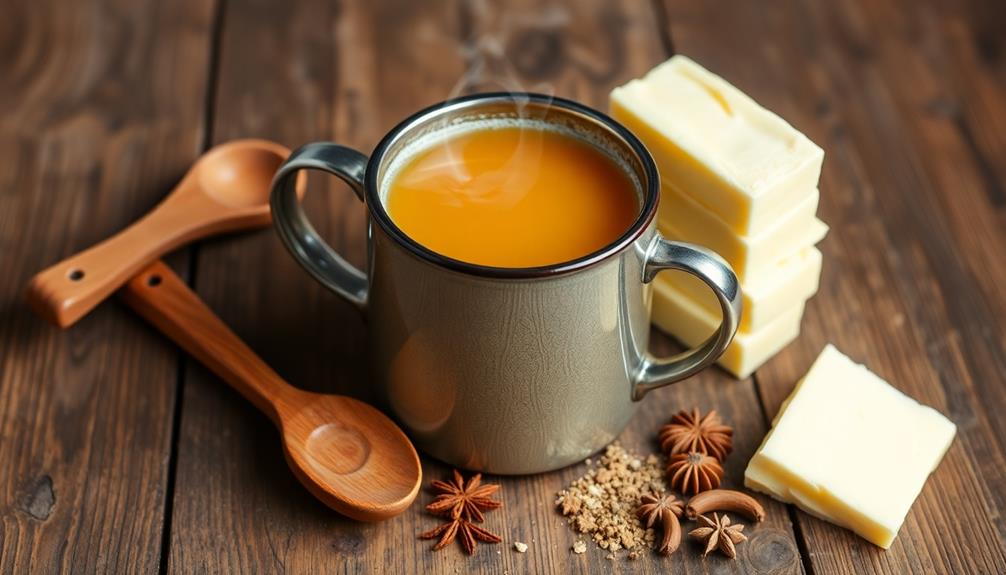
First, gather your black tea and yak butter.
Next, add the yak butter to a pot and bring it to a gentle simmer.
Step 1. Gather Black Tea and Yak Butter
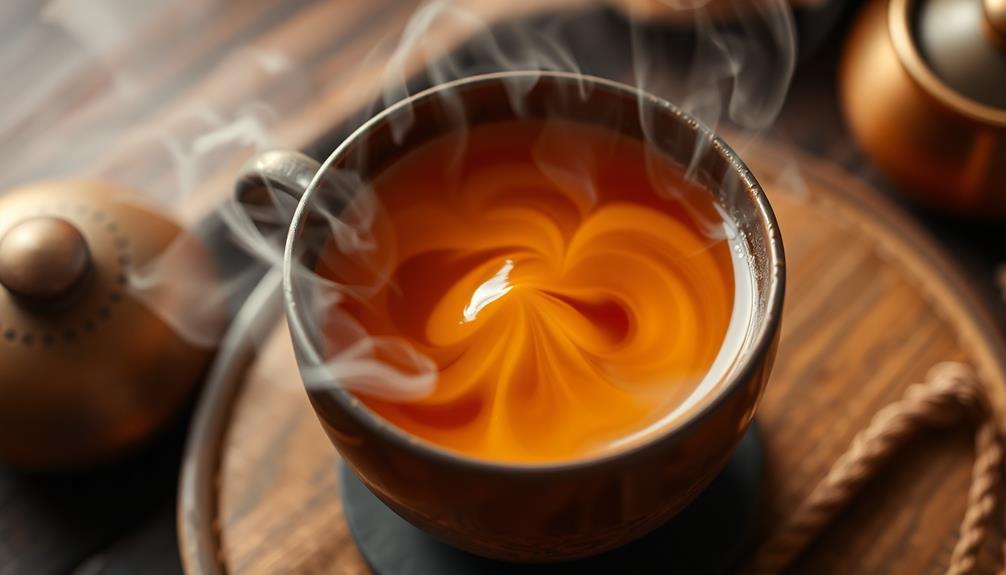
Gathering the necessary ingredients for the classic Tibetan butter tea begins with selecting high-quality black tea leaves and obtaining fresh yak butter.
Look for bold, full-bodied black tea that will stand up to the rich, creamy flavor of the yak butter. You'll want to find a reputable source for your yak butter, as this traditional ingredient is the heart and soul of this savory beverage.
Once you have your tea and butter, you'll need to prepare them for brewing.
Crush the tea leaves to release their robust aroma and flavor. Then, softly warm the yak butter until it's just melted, being careful not to let it get too hot. The key is to maintain the delicate balance of the tea's bold character and the butter's luscious mouthfeel.
With your ingredients ready, you can now begin the process of infusing them together to create the signature Tibetan butter tea.
Step 2. Add Yak Butter
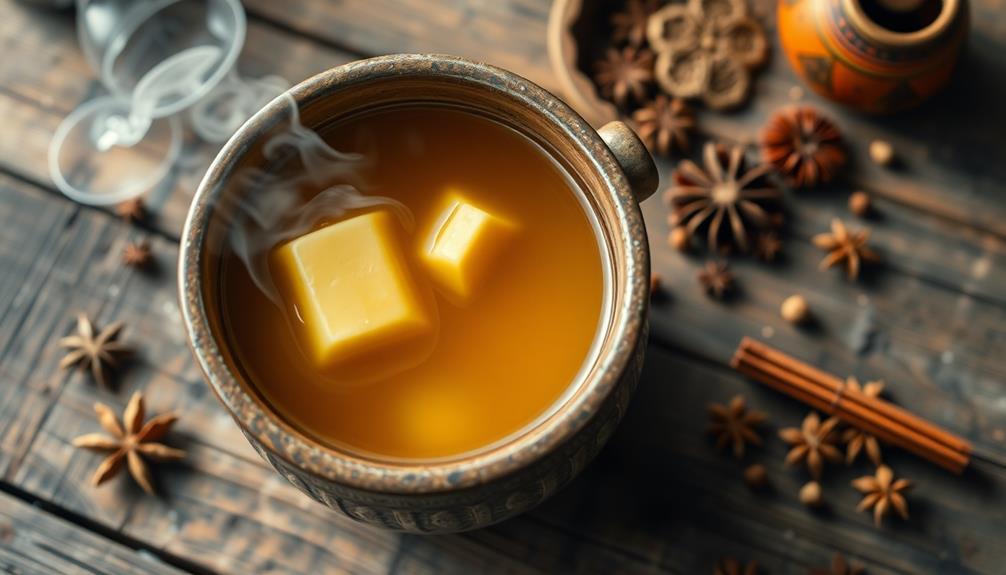
With your tea leaves crushed and the yak butter softened, you're ready to begin the process of infusing them together.
Grab a medium saucepan and add the softened yak butter. Gently melt the butter over medium heat, stirring occasionally. Once it's fully melted, pour in your freshly brewed black tea. Stir the mixture thoroughly, ensuring the butter and tea are well combined.
Allow the buttery tea to simmer for 5-7 minutes, letting the flavors meld together. The aroma of the rich, creamy tea will start to fill your kitchen, making your mouth water in anticipation.
As the tea simmers, the butter will melt completely, creating a silky, smooth texture. Stir the tea occasionally to prevent any skin from forming on top.
When the time is up, your Tibetan butter tea is ready to serve. Ladle the fragrant, golden liquid into your favorite mugs or bowls.
Enjoy the savory, comforting sip that warms you from the inside out.
Step 3. Bring to a Gentle Simmer
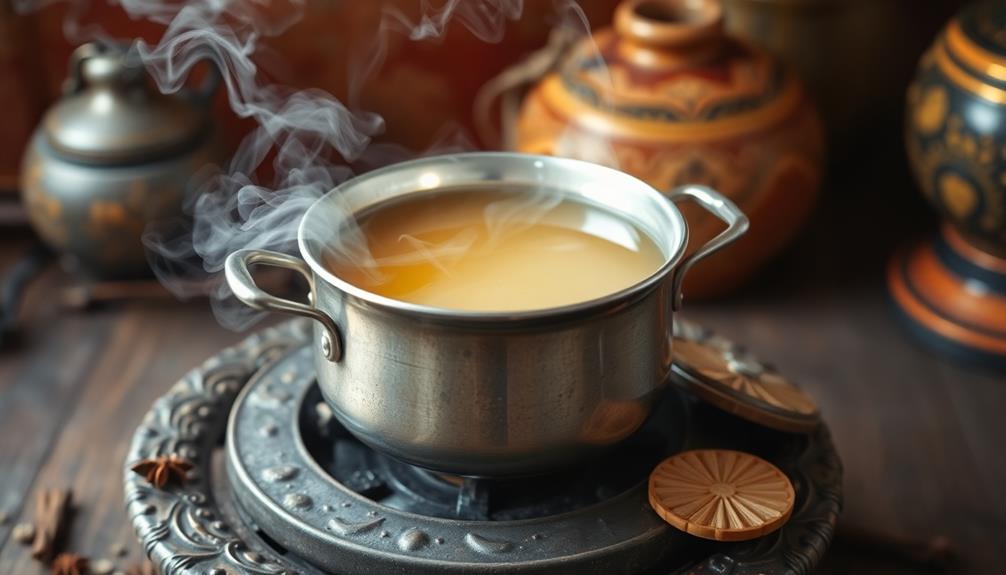
With the softened yak butter and freshly brewed black tea now combined in the saucepan, you'll want to bring the mixture to a gentle simmer.
Slowly increase the heat, keeping a close eye on the pan. As the liquid begins to bubble, you'll see tiny, delicate bubbles form and rise to the surface. Don't let the tea come to a rolling boil – that would make the flavors too intense and potentially scorch the butter.
Instead, maintain a gentle, steady simmer, allowing the ingredients to meld together harmoniously.
You'll notice the rich, creamy aroma of the yak butter wafting through the air, complementing the robust, earthy notes of the black tea.
Stir the mixture occasionally with a wooden spoon to ensure even heating. This low-and-slow approach allows the flavors to develop and the tea to become perfectly infused with the velvety butter.
After a few minutes of gentle simmering, your Tibetan butter tea will be ready for the next step – pouring into your favorite mug to enjoy its warm, comforting goodness.
Step 4. Pour Into Cups
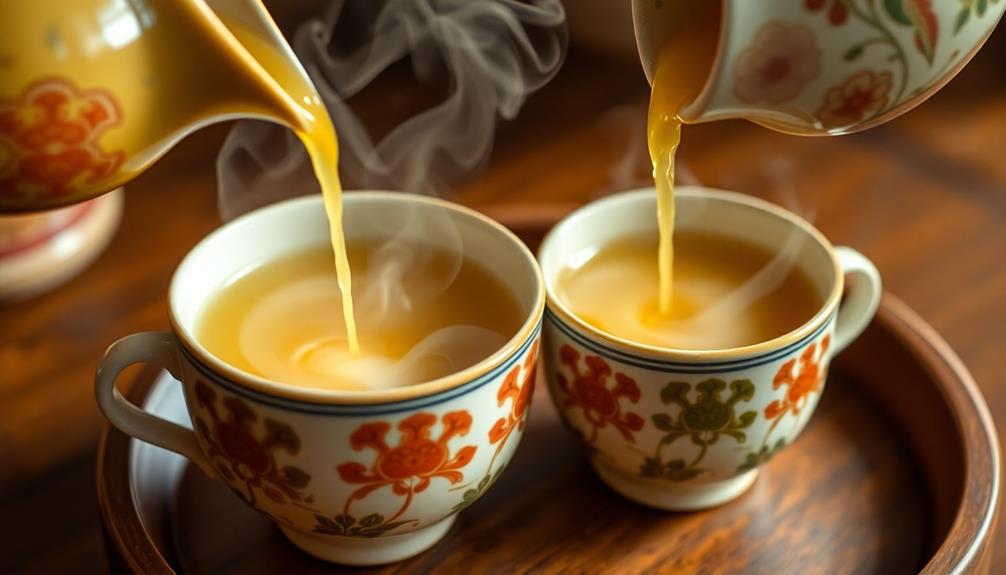
Once the Tibetan butter tea has reached a gentle simmer, carefully pour the fragrant liquid into your favorite mugs or cups. The rich, creamy texture and earthy aroma will immediately fill the air, enticing your senses.
Be mindful not to spill as you ladle the tea, ensuring an even distribution among the vessels. The golden-hued liquid should reach about three-quarters of the way up each cup, leaving ample room for the final touch – a dollop of fresh yak butter on top. This traditional beverage not only warms you up but also reflects the cultural significance of butter, which has evolved over centuries in various culinary traditions the historical evolution of butter.
Slowly drizzle the butter over the surface, watching it melt and swirl into the hot tea. The contrast of the smooth, velvety butter and the robust, slightly nutty flavor of the tea creates a harmonious blend that's truly unique to the Tibetan culinary tradition.
Inhale deeply, savoring the comforting scent, then take your first sip. The warmth envelops your body, while the balanced flavors dance across your palate, transporting you to the rugged Himalayan landscape.
Step 5. Enjoy the Aromatic Beverage
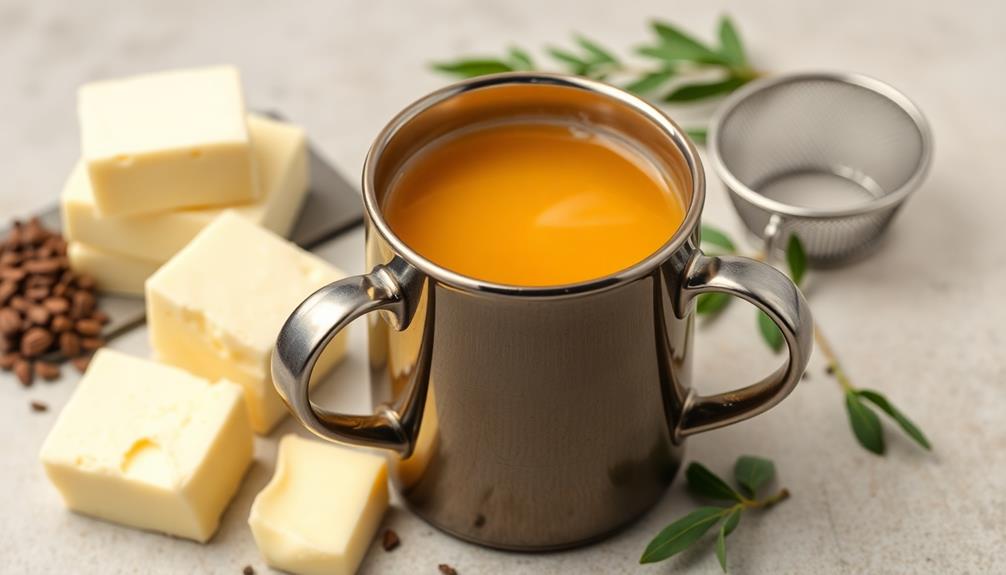
Take a moment to savor the aromatic beverage. As you bring the steaming cup to your lips, the captivating scent of Tibetan butter tea envelops your senses. The rich, creamy flavor dances on your tongue, a harmonious blend of black tea, yak butter, and a pinch of salt. Each sip warms you from the inside out, providing a comforting respite from the chill.
Gently blowing on the surface, you watch the steam swirl and dissipate, revealing the golden liquid waiting to be savored. With each subsequent sip, you discover new layers of flavor – the subtle earthiness of the tea, the velvety smoothness of the butter, and the perfect balance of saltiness that ties it all together.
The beverage's unique texture and robust taste make it a truly indulgent experience, transporting you to the heart of the Tibetan plateau.
As you empty your cup, you feel a sense of contentment and renewed vigor, ready to embrace the day ahead.
Final Thoughts
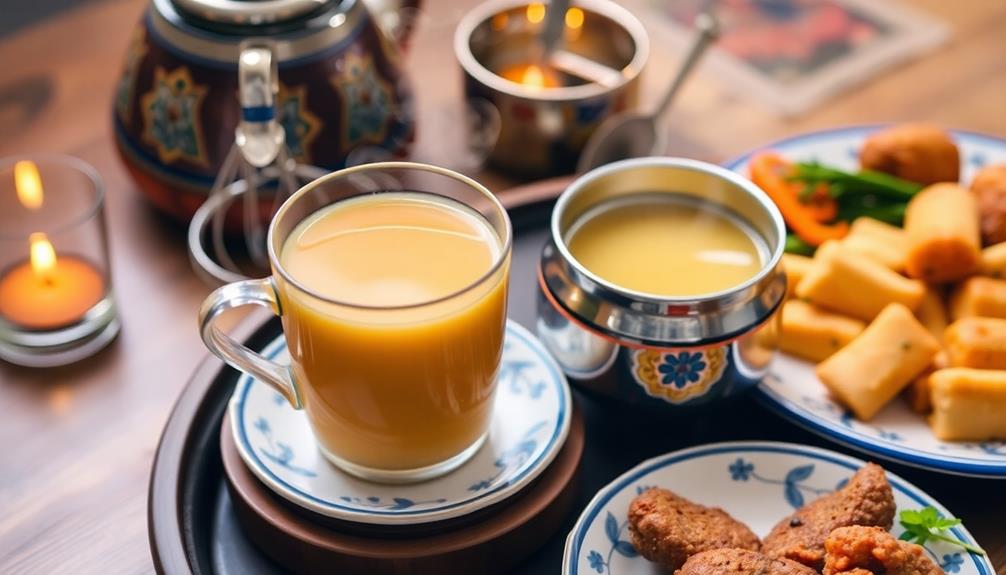
Amidst the rich tapestry of Tibetan culture, the alluring aroma and comforting warmth of butter tea have long captivated the senses. As you sip this unique and savory beverage, you're transported to the snow-capped peaks and rugged landscapes of the Himalayas. The blend of black tea, yak butter, and salt creates a truly distinctive flavor that warms the soul and nourishes the body.
Whether enjoyed during a contemplative moment or shared with friends, butter tea is more than just a drink – it's a cherished tradition that embodies the resilience and adaptability of the Tibetan people.
Its preparation, with the rhythmic churning and blending of ingredients, is a calming ritual that connects you to the rich cultural heritage. As you savor each sip, you can't help but appreciate the ingenuity and resourcefulness that went into crafting this age-old recipe, perfectly suited to the harsh yet beautiful Tibetan environment.
Truly, butter tea is a remarkable elixir that invites you to slow down, savor the moment, and immerse yourself in the captivating world of Tibetan culture.
Frequently Asked Questions
How Long Does Tibetan Butter Tea Last Before Spoiling?
Tibetan butter tea can last up to a week in the refrigerator, but it's best consumed fresh. The rich, creamy texture and flavor won't last long, so enjoy it while it's at its peak.
Can Tibetan Butter Tea Be Consumed Cold?
Can Tibetan butter tea be consumed cold? Absolutely! While it's traditionally served hot, you can enjoy this savory beverage chilled on a hot day. The rich, creamy texture and bold flavors make it a refreshing treat.
What Are the Health Benefits of Drinking Tibetan Butter Tea?
Drinking Tibetan butter tea can provide you with health benefits like boosting energy, improving digestion, and supporting heart health. The high-fat content and nutrients in the tea can also help keep you warm on chilly days.
Can Tibetan Butter Tea Be Made With Different Types of Tea Leaves?
You can absolutely make Tibetan butter tea using different types of tea leaves. While black and oolong teas are traditional, you can experiment with green, white, or even herbal teas to create your own unique version.
How Does the Taste of Tibetan Butter Tea Compare to Regular Black Tea?
Compared to regular black tea, Tibetan butter tea has a richer, creamier, and more savory flavor profile. The addition of yak butter and salt creates a unique taste experience that's quite different from the lighter, more astringent notes of black tea.
